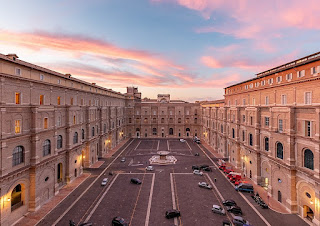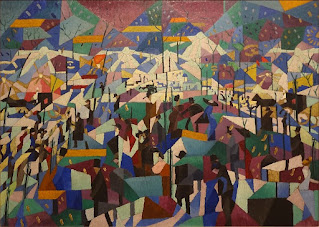NEW - Donato Bramante - architect and painter
Father of High Renaissance style left outstanding legacy
The architect and painter Donato Bramante, credited with introducing High Renaissance architecture to Rome, died on this day in 1514 in Rome, probably aged around 70. Bramante, who was also a perspectivist painter, worked in Milan before moving to Rome, where he produced the original designs for St Peter’s Basilica and built several buildings and structures considered to be masterpieces of early 16th century architecture. These include the Tempietto di San Pietro in Montorio on the summit of the Janiculum Hill, the Chiostro di Santa Maria della Pace near Piazza Navona, the Cortile del Belvedere and Scala del Bramante in the Vatican and the Palazzo della Cancelleria, located between Campo de' Fiori and Corso Vittorio Emanuele II. Bramante was born Donato di Pascuccio d'Antonio in around 1444 to a well-to-do farming family in Fermignano, a town in what is now the Marche region, a few kilometres south of Urbino. He was also known as Bramante Lazzari. Little is known of his early life, although it is possible he worked on the construction site of Federico da Montefeltro's Palazzo Ducale in Urbino, having trained under its architect, Luciano Laurana. Read more…
______________________________________
Primo Levi - Auschwitz survivor
Celebrated writer killed in fall in Turin
Primo Levi, an Auschwitz survivor who wrote a number of books chronicling his experiences of the Holocaust, died on this day in Turin in 1987. He was 67 years old and his body was found at the foot of a stairwell in the apartment building where he lived, having seemingly fallen from the third floor. A chemist by profession, Levi died in the same building in which he was born in July 1919, in Corso Re Umberto in the Crocetta district of the northern Italian city. Apart from his periods of incarceration, he lived in the same apartment, a gift from his father to his mother, almost all his life. His death was officially recorded as suicide, the verdict supported by his son's statement that his father had suffered from depression in the months leading to his death. He had undergone surgery for a prostate condition and was worried about the failing health of his 92-year-old mother. Some of his friends, however, doubted that he would have taken his own life and believed he had fallen accidentally. They argued that while other survivors never recovered from the mental scarring, Levi had emerged with "soul and psyche intact" and retained a hopeful and positive outlook. Read more…
______________________________________
Rachele Mussolini - wife of Il Duce
Marriage survived 30 years despite dictator's infidelity
Rachele Mussolini, the woman who stayed married to Italy’s former Fascist dictator for 30 years despite his simultaneous relationship with his mistress, Claretta Petacci, and numerous affairs, was born on this day in 1890. The daughter of Agostino Guidi, a peasant farmer, and Anna Lombardi, she was born, like Benito Mussolini, in Predappio, a small town in what is now Emilia-Romagna. They met for the first time when the future self-proclaimed Duce had a temporary teaching job at her school. They were married in December 1915 in a civil ceremony in Treviglio, near Milan, although by that time she had been his mistress for several years, having given birth to his eldest daughter, Edda, in 1910. Mussolini had actually married another woman, Ida Dalser, in 1914 but the marriage had broken down despite her bearing him a son, Benito junior, and Mussolini returned to Rachele. Her father had cautioned her against marrying Mussolini, whom he considered to have no prospects, but when Agostino died, his widow became the lover of Mussolini’s father, Alessandro, himself a widower. Read more…
_______________________________________
Battle of Ravenna
Thousands die in pointless conflict of the Italian Wars
French forces inflicted appalling casualties upon a largely Spanish Holy League army on this day in 1512 at Molinaccio just outside Ravenna. The French, under the command of their brilliant 21-year-old leader Gaston de Foix, had taken Brescia in Lombardy by storm in February and then marched on Ravenna intending to provoke the papal Holy League army into battle. They also had an Italian contingent of soldiers with them under the command of Alfonso I d’Este, Duke of Ferrara. Ramon de Cardona, Spanish viceroy of Naples and commander of the Holy League forces, led an army through the papal states of the Romagna to relieve Ravenna, passing Forlì and advancing north along the Ronco river. Both sides had learned the new rules of warfare in the gunpowder age and were reluctant to assault well defended earthworks with cavalry or infantry. They indulged in an artillery duel and had to manoeuvre unwieldy cannons to find effective lines of fire. But after two hours they changed tactics and both cavalry and infantry threw themselves forward in assaults. The casualties were heavy as horsemen clashed in swirling melees and infantry swarmed over ramparts and ditches. Read more…

.jpg)

.JPG)

.jpg)



.jpg)






.jpg)



%20(2).jpg)


.jpg)
_(14770663784).jpg)
%20(1).jpg)

.jpeg)




